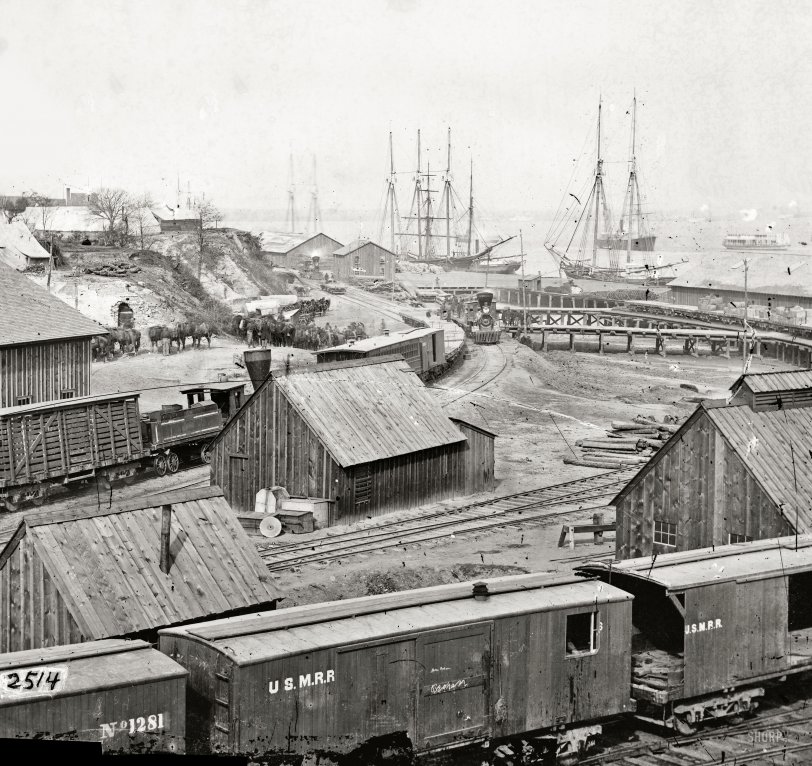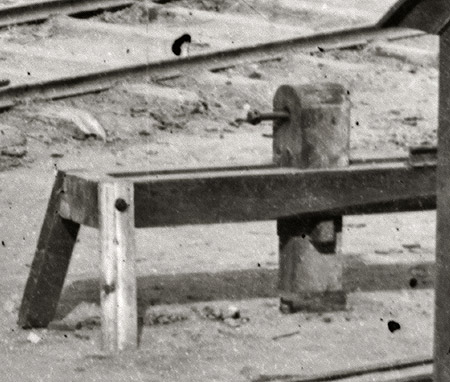


Framed or unframed, desk size to sofa size, printed by us in Arizona and Alabama since 2007. Explore now.
Shorpy is funded by you. Patreon contributors get an ad-free experience.
Learn more.

- Tough Guys
- Lost in Toyland
- And without gloves
- If I were a blindfolded time traveler
- Smoke Consumer Also Cooks
- Oh that stove!
- Possibly still there?
- What?!?
- $100 Reward
- Freeze Frame
- Texas Flyer wanted
- Just a Year Too Soon
- WWII -- Replacing men with women at the railroad crossing.
- Yes, Icing
- You kids drive me nuts!
- NOT An Easy Job
- I wonder
- Just add window boxes
- Icing Platform?
- Indiana Harbor Belt abides
- Freezing haze
- Corrections (for those who care)
- C&NW at Nelson
- Fallen Flags
- A dangerous job made worse
- Water Stop
- Passenger trains have right of way over freights?
- Coal
- Never ceases to amaze me.
- Still chuggin' (in model form)
Print Emporium
Ways of Going: 1865

Circa 1865. "City Point, Virginia. Railroad yard and transports." Wet plate glass negative, half of stereograph pair. Studio of Mathew Brady. View full size.
Locomotive Smokestacks
There is a lot about those smokestacks that a photograph will not show. Inside there is a cast iron deflector that diverts the exhaust blast downwards and at the top is a heavy wire mesh screen. Coal burning locos used a straight stack as they did not create sparks to amount to anything, but the wood burners needed something to keep them from setting the scenery on fire. There were one or two cleanout doors near the bottom of the stack to allow for removal of the settled cinders. The locomotives in the photo are all of "American Standard" design and had four-wheel trucks up front to guide the four main drive wheels. For those in the know, the wheel arrangement was called 4-4-0.
Mopping Up
On the side of the boxcar in the foreground, next to its door on which "BROKEN" is scrawled, hangs a mop! Anyone have an idea of the mop's purpose?
Interesting place to visit
You can still walk along one area where the original track was laid around that bluff next to the river as seen in one civil war photograph. This was an important Union military center with trains departing this location for the front on a daily basis.
The rail transportation system was so efficient at this location that fresh baked bread was still hot when it arrived for the soldiers at the front.
General Grant had his command post not very far from here on top of the bluff.
Transition of technologies
Remarkable scene of a busy waterfront showing the transition of wind-powered clippers to steam-powered ships, of mule trains to locomotion. i love the stack of wagon wheels on the dock. Another great Shorpy photo.
Second Look at Ships
East Coast three masted schooners were called "tern schooners."
The vessel moored outboard of "our" tern schooner is technically a half brig or hermaphrodite brig, although today it could be called a brigantine. In the 19th C, brigantines had upper, square sails on their mainmasts in addition to their gaff mainsail. (That rig is no longer seen today even for yachts or training ships.)
The smokestack immediately aft of its mainmast can't possibly belong to this ship, because it would obstruct the swing of the main boom, as well as presenting a fire hazard to the mainsail. It's about the right size to belong to a steam tug moored on the outboard side of the half brig.
Hurry Up and Wait
There is a lot of activity in this photo. Whether it is efficient activity or not is impossible to judge.
Great photograph
Technically this is a great photograph; historically it is magnificent. You can just feel the moment and can also appreciate the sheer strength and efficiency of the (relatively) young United States.
Mystery Object
I wondered if anyone might know what this is? It somewhat resembles a lathe. Possibly some kind of woodworking equipment, as there seems to be a large saw blade next to one of the buildings and perhaps a pile of unfinished railroad ties near there as well.

Balloon Stacks
Those funnel-shaped smokestacks (aka "balloon stacks") were designed to keep sparks from escaping, esp. from wood-fired locomotives of that era.
Great photo!
Ships
Great depth of focus (if that's the correct term -- I mean you can clearly see details in the far distance). I'm fascinated by the ships. Looks like your standard schooner docked at the right. The inboard ship on the left appears to be a three-masted schooner. The outboard one looks like a brigantine -- could it be a type of Baltimore Clipper? It looks like it has steam power too.
Locomotive smokestacks
Once again, I'm sent to wondering why the locomotives of that era had those huge, funnel shaped smokestacks. Seems like a stovepipe type would eject smoke just as well, or am I missing something by way of aerodynamics?
That said, another magnificent moment frozen in time.
A lot to see
I'm always amazed at the detail in these photos you post. From the word "Broken" chalked on the rail car to the piles of wheels on the dock. And with a bit of exposure time, we can see the moving masts of a ship at dock.
Last Push
You can really feel the war coming to an end in this picture. All the stops were pulled out with this drive. Great picture. Is now my desktop background.
























On Shorpy:
Today’s Top 5